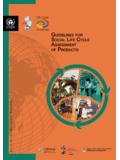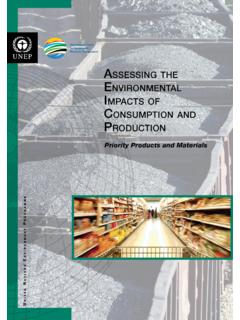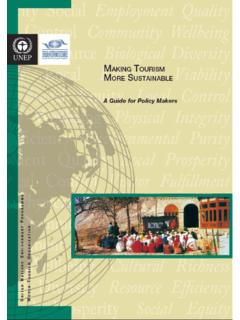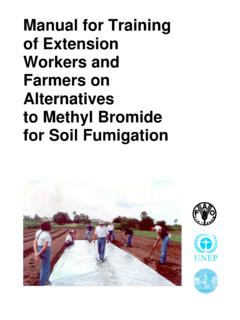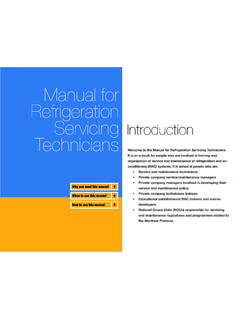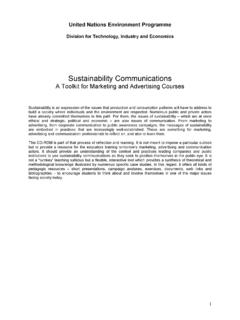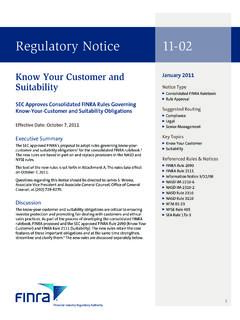Transcription of The Kigali Amendment to the Montreal Protocol: HFC …
1 OZONACTION FACT SHEET The Kigali Amendment to the Montreal protocol : HFC Phase-down The Parties to the Montreal protocol on Substances that Deplete the Ozone Layer reached agreement at their 28th Meeting of the Parties on 15 October 2016 in Kigali , Rwanda to phase-down hydrofluorocarbons (HFCs). HFCs are commonly used alternatives to ozone depleting substances (ODS). While not ozone depleting substances themselves, HFCs are greenhouse gases which can have high or very high global warming potentials (GWPs), ranging from about 121 to 14,800.
2 The phase-down of HFCs under the Montreal protocol has been under negotiation by the Parties since 2009 and the successful agreement on the Kigali Amendment (Decision XXVIII/1 and accompanying Decision XXVIII/2) continues the historic legacy of the Montreal protocol . This fact sheet summarises and highlights the main elements of the Amendment of particular interest to countries operating under Article 5 of the protocol (Article 5 Parties). The Kigali Amendment adds to the Montreal protocol the phase-down of the production and consumption of HFCs.
3 The main features of the Amendment are the following: 4 The Kigali Amendment will enter into force on 1 January 2019, provided that it is ratified by at least 20 Parties to the Montreal protocol (or 90 days after ratification by the 20th Party, whichever is later). 4 There are two groups of Article 5 Parties with different baseline years and phase-down schedules (see chart and graph on page 2). 4 Some non-Article 5 Parties have different baseline calculations and different initial phase-down steps from the main group of non- Article 5 Parties (see chart and graph on page 3).
4 4A new Annex F has been added to the protocol . This lists the HFCs, separated into two groups: Annex F, Group I: all HFCs (except HFC-23, and HFOs1) Annex F, Group II: HFC-23. 4 Global warming potential values have been added to the protocol text for HFCs, and selected HCFCs and CFCs (see page 6). 4 Production, consumption, imports, exports and emissions as well as consumption baselines of HFCs shall be expressed in carbon dioxide (CO2) equivalents. 4 Baselines are to be calculated from both HFC and HCFC production/consumption. 4 There is an exemption for high ambient temperature countries (see page 5).
5 4 Import and export licencing systems for HFCs must be in place by 1 January 4 Trade with Parties that have not ratified the Amendment ( non-Parties ) will be banned from 1 January 4 The Executive Committee is requested develop, within two years, guidelines for financing the phase-down of HFCs. A timeline of the HFC phase-down is provided on page 4. Photo by IISD/ENB | Kiara Worth INTRODUCTION OVERVIEW OF Amendment Article 5 Parties are divided into two groups: Group 1: The majority of Article 5 Parties. Group 2: Bahrain, India, Iran, Iraq, Kuwait, Oman, Pakistan, Qatar, Saudi Arabia, and the United Arab Emirates.
6 Group 2 has a later freeze and phase-down steps compared with Group 1. The freeze date is four years later (2028 compared with 2024). ARTICLE 5 PARTIES HFC PHASE-DOWN Shutterstock Summary Article 5 Parties: Group 1 Article 5 Parties: Group 2 Baseline Years 2020, 2021 & 2022 2024, 2025 & 2026 Baseline Calculation Average production/consumption of HFCs in 2020, 2021, and 2022 plus 65% of HCFC baseline production/consumption Average production/consumption of HFCs in 2024, 2025, and 2026 plus 65% of HCFC baseline production/consumption Reduction steps Freeze 2024 2028 Step 1 2029 10% 2032 10% Step 2 2035 30% 2037 20% Step 3 2040 50% 2042 30% Step 4 2045 80% 2047 85% Phase-down schedule and thereafter Non-Article 5 Parties do not have freeze in consumption.
7 Their first control measure is a 10%, or a 5% reduction. Several non-Article 5 Parties (Belarus, the Russian Federation, Kazakhstan, Tajikistan, and Uzbekistan) have a different formulation for the calculation of baseline (see summary below) and have different initial phase-down steps from the other non-Article 5 Parties ( the first two steps). The final phase-down dates are the same for all Non-Article 5 Parties (production and consumption). NON-ARTICLE 5 PARTIES HFC PHASE-DOWN Summary Non- Article 5 (Main Group) Non- Article 5.
8 Belarus, the Russian Federation, Kazakhstan, Tajikistan & Uzbekistan Baseline Years 2011, 2012 & 2013 2011, 2012 & 2013 Baseline Calculation Average production/consumption of HFCs in 2011, 2012 & 2013 plus 15% of HCFC baseline production/consumption Average production/consumption of HFCs in 2011, 2012 & 2013 plus 25% of HCFC baseline production/consumption Reduction steps Step 1 2019 10% 2020 5% Step 2 2024 40% 2025 35% Step 3 2029 70% 2029 70% Step 4 2034 80% 2034 80% Step 5 2036 85% 2036 85% Phase-down schedule and thereafter HFC PHASE-DOWN TIMELINE out Baselines will be calculated from past HCFC consumption/production baselines plus the HFC consumption/production in 2020-2022 or 2024-2026 for Article 5 Parties, and 2011-2013 for non-Article 5 Parties.
9 The basis for including both HFCs and a percentage of HCFCs is because, while HCFCs are being phased-out through already-approved HCFC Phase-out Management Plans (HPMPs), HFCs may be used as alternatives for some portion of HCFCs. The HCFC component is intended to account for this portion in the baseline. When calculating levels of production, consumption, imports, exports and emissions of HFCs and HCFCs these will be expressed in CO2 equivalents and each Party shall use the GWP values in Annexes C and F of the protocol to calculate these.
10 Photo by IISD/ENB | Kiara Worth The cut-off date for eligible capacity is 1 January 2020 for those Parties with baseline years from 2020 to 2022 (Group 1) and 1 January 2024 for those Parties with baseline years from 2024 to 2026 (Group 2). ELIGIBLE CAPACITY CUT-OFF DATE There is an exemption for Parties with high ambient temperature conditions where suitable alternatives do not exist for the specific sub-sector of use. This exemption allows for a delay in the HFC freeze date and initial control obligations by an initial duration of four years.
